A Complete Guide to Engaging Your High-Value Customers with SMS Marketing
Published on April 16, 2024/Last edited on April 16, 2024/20 min read
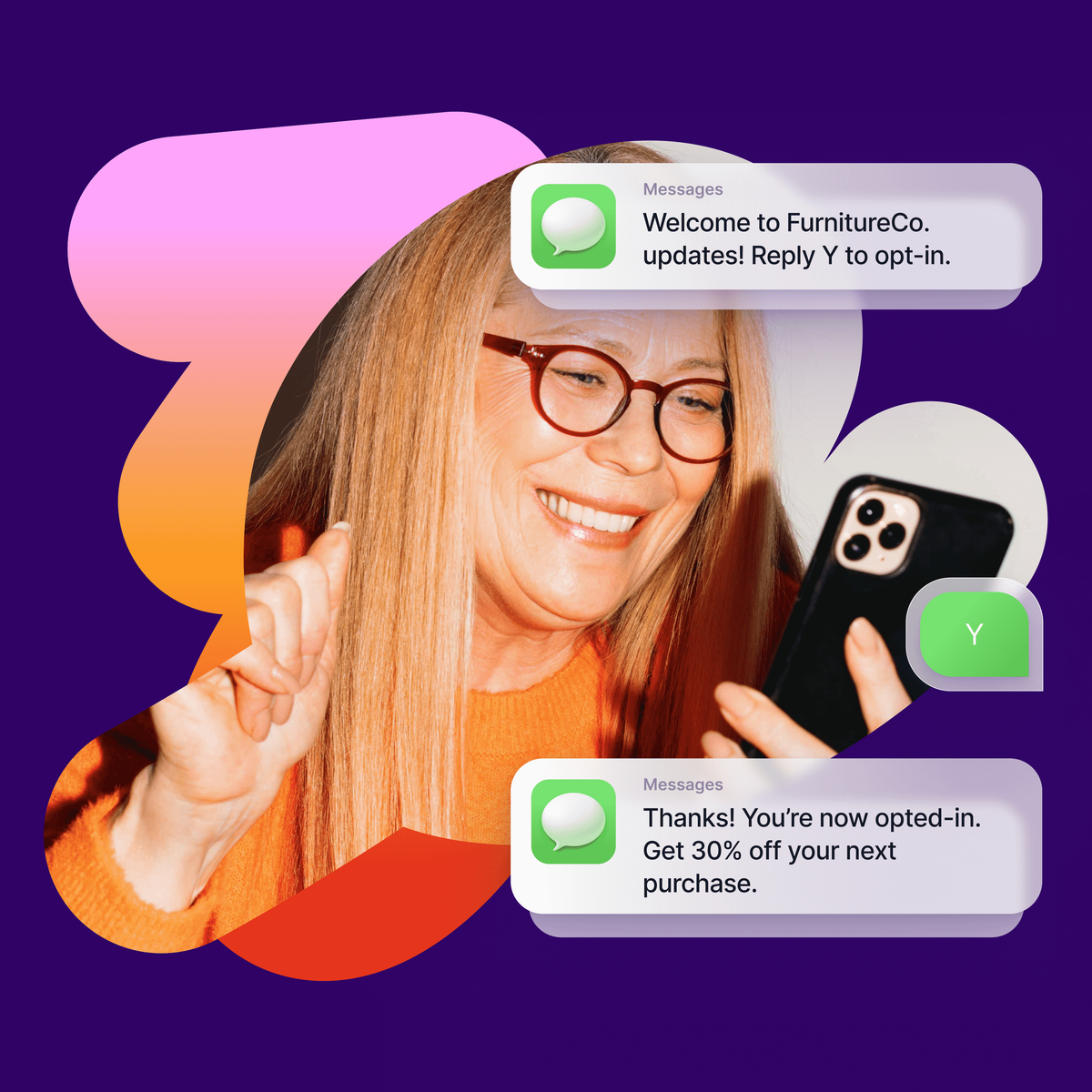

Team Braze
When it comes to messaging channels, SMS is something special. Simple, powerful, impactful—and because it started off as a way for people to connect one-on-one with friends and family, it has a reach and impact that few channels can touch. That's a major opportunity for marketers, but it also comes with some important responsibilities; the fact that the channel is so intimate and personal to so many people means that brands need to use it thoughtfully.To help marketers use this channel in smart, thoughtful ways, we’re going to explore what SMS marketing is, why it’s important for customer engagement, and how to leverage it to successfully engage your high-value customers on mobile. Additionally, we’ll look at exactly how SMS marketing can be used, walk through examples of some key SMS use cases, and share a few exciting case studies for inspiration.
- What is SMS Marketing?
- Why Is SMS Marketing Important?
- What’s the Difference Between SMS marketing and MMS marketing?
- How to Grow A Highly Engaged Audience for SMS Marketing
- 10 High-Impact SMS Marketing Use Cases
- 5 Real-life Examples of SMS Marketing
- 4 Ways A Customer Engagement Platform Can Support SMS Marketing
- Final Thoughts
- SMS Marketing FAQs
What is SMS marketing?
SMS stands for "short message service." However, they're more commonly called text messages. And in the customer engagement world, SMS marketing means sending text messages to users in order to engage them, though that outreach can be transactional (e.g. "Your delivery is on the way") or promotional (e.g. "Take 20% off these jorts!") in nature. Ultimately, these messages are generally meant to keep recipients informed or to encourage them to take key actions like making a purchase or visiting a webpage.
Why is SMS marketing important?
At a fundamental level, SMS is important because it works. These messages really grab recipients—SMS has very high open rates (98%, with 90% of messages being opened within just three minutes), making this channel a particularly effective way to reach your high-value customers and drive a strong return on investment.
With SMS, marketers can use this dynamic, owned marketing channel to target high-value mobile customers with personalized and conversational messages that capture attention, convert customers, and foster brand loyalty on their channel of choice. It's also an elegant way for consumers to stay up to date with the latest updates and offers from the brands they care about. This channel can support a range of key use cases, including:
- Account updates and alerts
- Appointment reminders
- Fraud alerts
- Order tracking/fulfillment
- Promotional messages
In addition, SMS has a number of capabilities and traits that provide unique advantages for marketers, supporting stronger performance and better customer relationships. These include:
Universal reach: Nearly every mobile phone in the world can receive text messages. In comparison, push notifications require a user to download an app and then turn on notifications.
High engagement and monetization: SMS campaigns can help increase engagement by 139% and monetization by 1,566%, compared to sending no messages via any channel.
Seamless customer feedback collection: Brands can use SMS to get quick feedback from customers about their preferences or recent experiences.
Instant impact: 90% of SMS messages are opened within 3 minutes. Unlike emails, text messages are less likely to go unseen and unread for days.
Stronger relationships: SMS messaging is more personal. Consumers are more likely to text their friends and family than email them, so receiving a text from their favorite brand feels a little more personal.
Enhances the marketing mix: SMS marketing can be a particularly high-impact part of a cross-channel approach that can be effective for engaging your high-value, loyal customers.
What’s the difference between SMS marketing and MMS marketing?
As discussed above, SMS is a brief, text-focused notification that can be sent either by a brand to a customer (i.e., to announce a sale or let you know you have a scheduled appointment coming up), or between friends and family members. SMS messages are natively supported by most mobile phones and have a 160-character limit.
MMS stands for “multimedia messaging service.” Unlike SMS, they can be used to send a message that also includes rich content, such as an image, GIF, video, or other visual element. MMS messages have some restrictions on where in the world they can be received and image-size limits (usually below 5MB, including the multimedia asset and the message body size).
How to grow a highly engaged audience for SMS marketing
To grow a highly engaged audience for your SMS marketing efforts, you need to ensure that you're on top of two key things. First, you need to understand the phone number types available to you and choose ones that fit your audience and your specific business needs. Second, you need to think through your SMS list-building strategy in order to successfully communicate your SMS program's value proposition in a clear, effective way and garner opt-ins.
Phone number types: How to pick the right one for your business
Before you can begin sending SMS to your customers, you need a solid understanding of the challenges and opportunities associated with each of the different phone number types associated with SMS. Without that insight, you raise the risk of choosing a phone number type that doesn’t serve your needs or the needs of your audience.
The major phone number types are:
- 10 Digit Long Codes (10DLC) — A ten-digit long code is a long code that requires a specific registration process. Because long codes were historically used for P2P (peer-to-peer) messaging, a new A2P (application-to-person) registration process was created by the mobile carriers specifically to facilitate A2P messaging using long codes.
- Short Codes — A five- or six-digit number available in the US, Canada, UK, and a number of other countries that brands can use to send and receive text messages to and from customers.
- Vanity Short Codes — This one is a kind of short code that brands can customize in order to align the number to their brand name or brand identity. All of the pros and cons for short codes apply here, with the added benefit that they’re the easiest type of phone number for customers to remember and ideal for text-to-join campaigns.
- SMS-Enabled Toll-Free Numbers — These sending numbers can be used to send SMS campaigns that leverage the existing toll-free numbers that customers already use to contact your company.
- Alphanumeric Sender IDs — This special type of SMS phone number allows brands to send messages that list their company name or brand as the sender ID, instead of displaying a phone number.
Not sure which to choose? Check out our quick overview below:
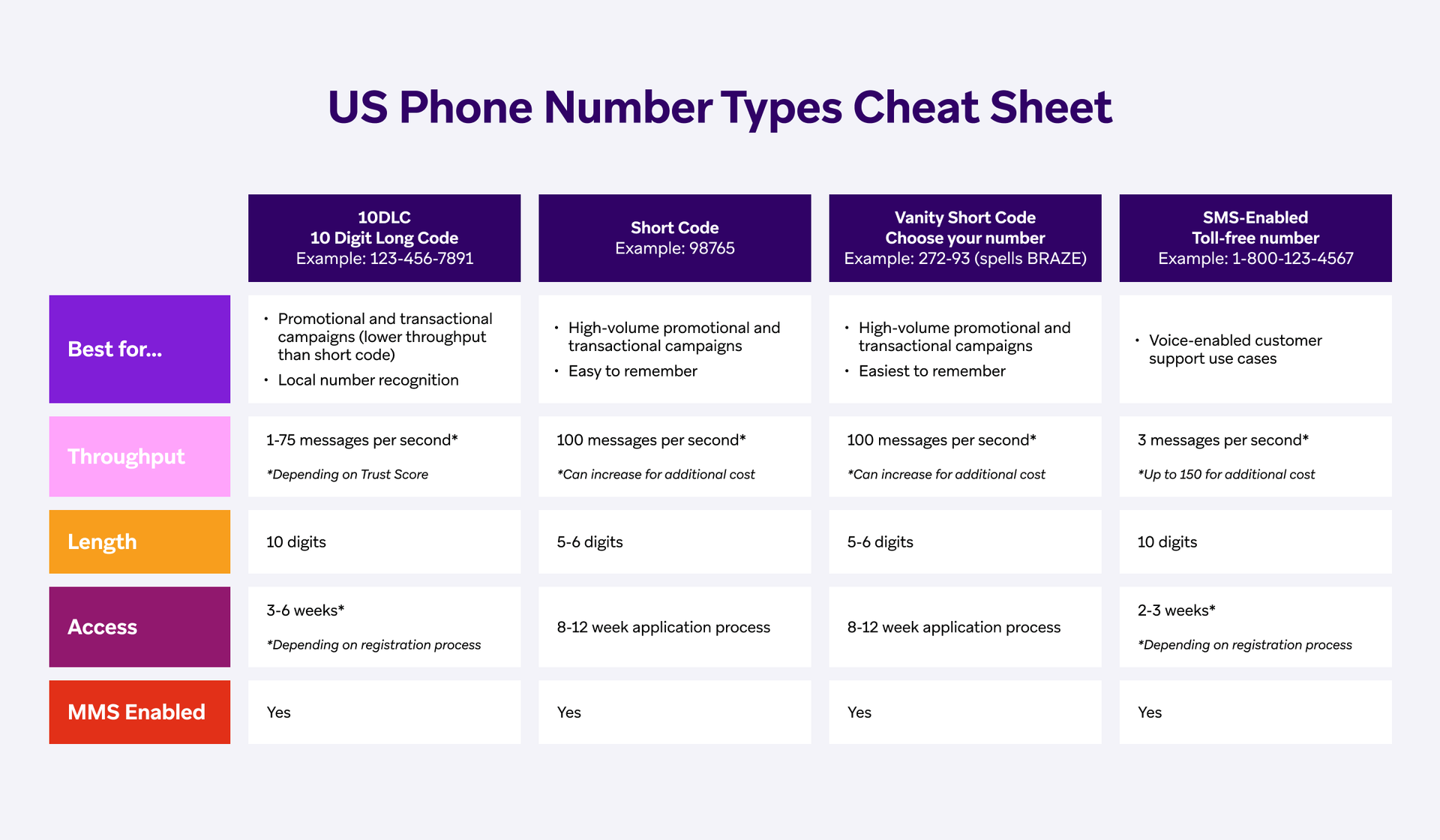
There are some key factors that can influence which SMS phone number type you choose, including: How many campaigns you’re going to want to send in a given time; how fast you want those messages sent (i.e. the throughput); and how quickly you’re looking to start sending messages. As you’re assessing these factors, make sure to think through both your current needs and what you are likely to want in the future; choosing a number type that can’t scale with your SMS marketing plans can make it hard to grow the impact of this channel over time.
SMS list building: What you need to know
Encouraging users to subscribe to your SMS program requires careful consideration, a transparent communication of your SMS value propositions, and thoughtful experimentation. Let’s dig into the different types of list-building campaigns you can use to drive more SMS-subscribed users and the various strategies you can leverage to boost the odds that they opt in.
Common List-Building Campaign Types
1. Phone Number Capture Campaigns
These campaigns nudge individuals to voluntarily share their phone number and opt-in for future SMS marketing campaigns. They tend to work best for:
- 10DLC or toll-free sending phone numbers
- Digital channels only (i.e., when you’re collecting phone numbers within your app or on your website)
- Scenarios where you do not have customer phone numbers on existing customer profiles within your customer engagement platform
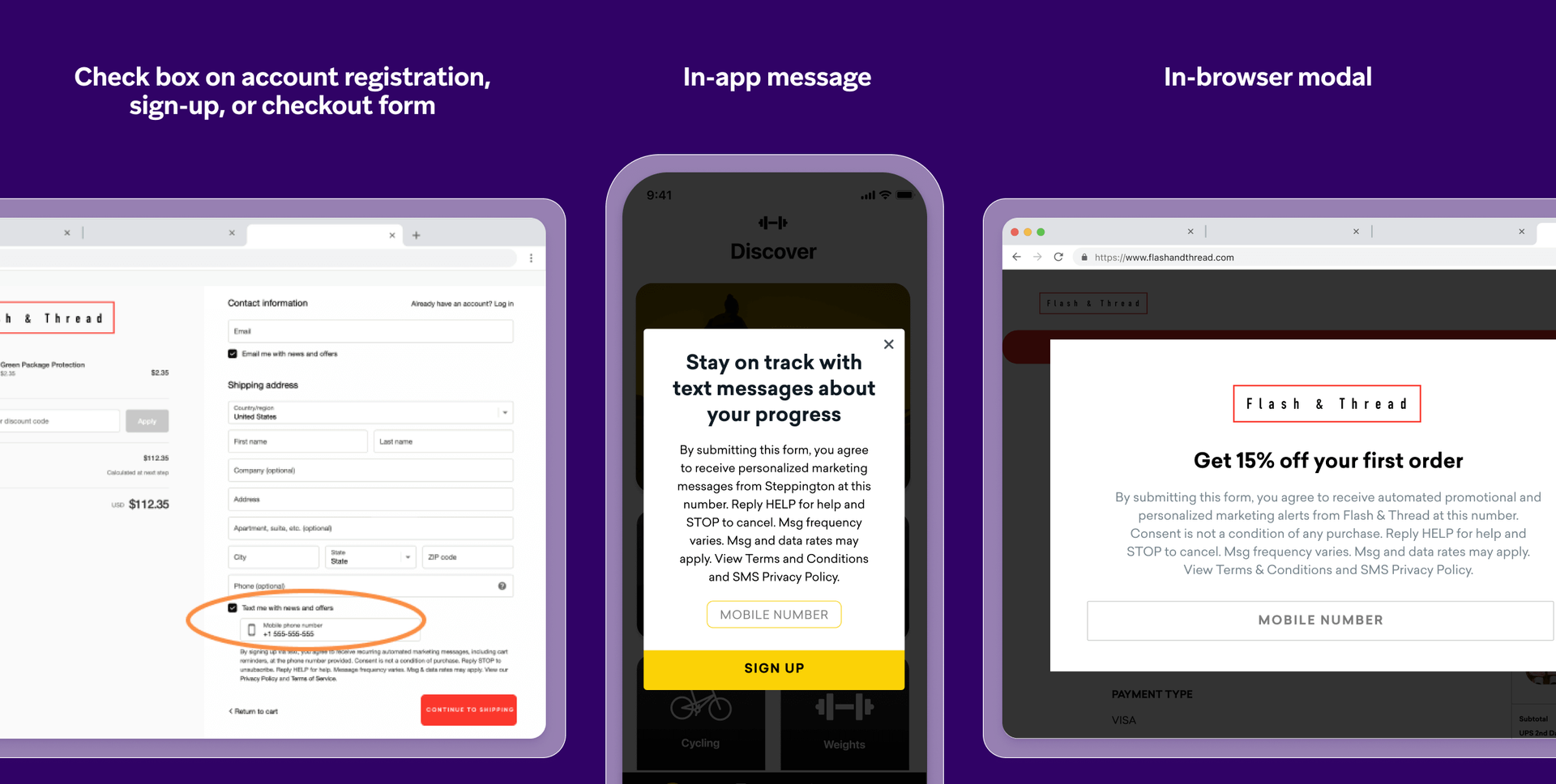
2. Text-to-Join Campaigns
These campaigns, which encourage users to opt in for SMS by texting an activation keyword to the brand, take a different approach to driving SMS sign-ups, supporting additional channels and use cases. They tend to work best for:
- Short codes, which are easier for customers to remember
- In-store signage, billboards, and commercials
- Digital channels (i.e. when you want to promote your text-to-join campaign on your app or website)
- Scenarios where you already have customer phone numbers on existing customer profiles within your customer engagement platform, so you can associate the opt-ins
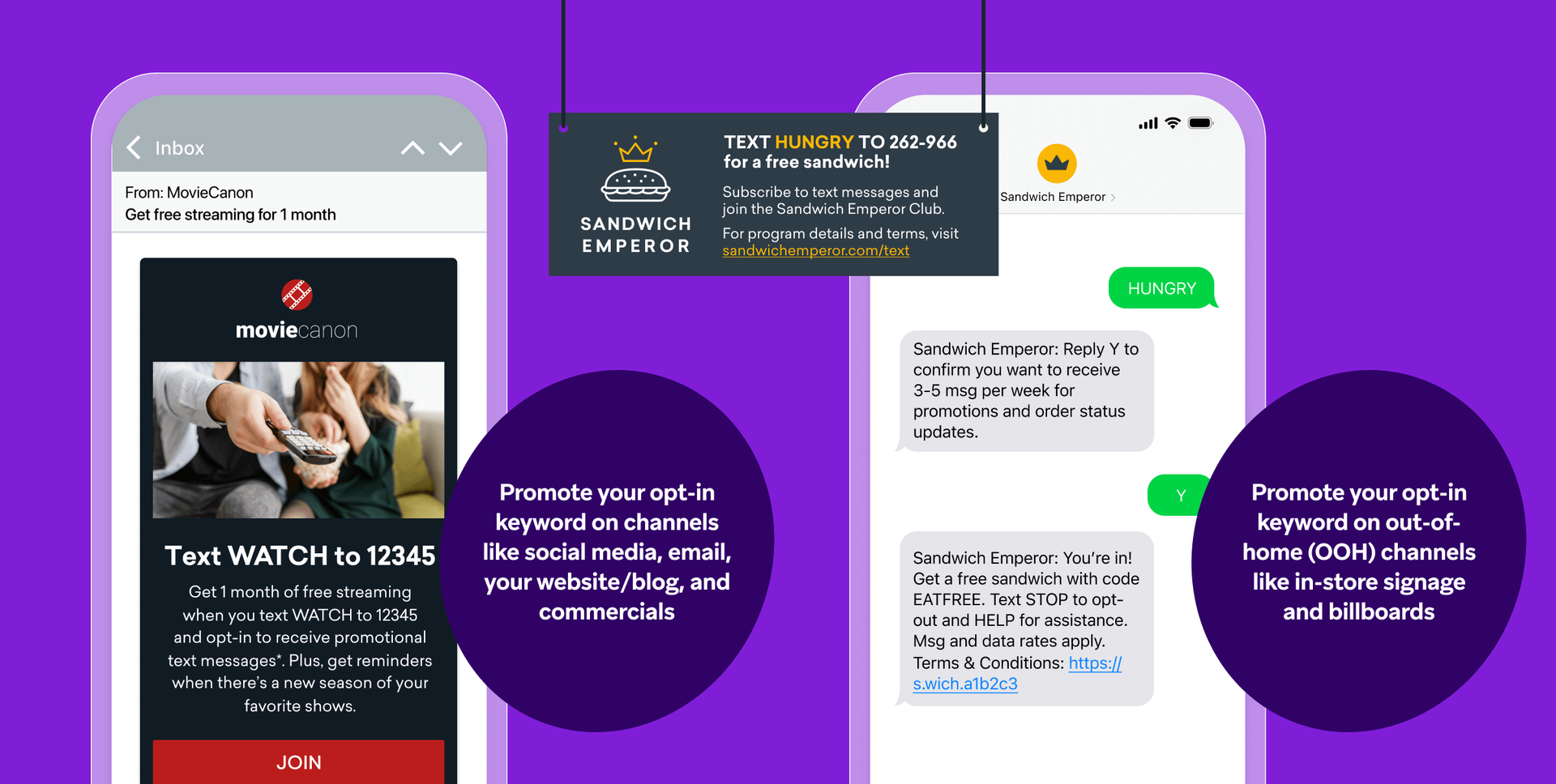
Key List-Building Strategies
The core idea around SMS list-building is deceptively simple—that is, you need to give people a compelling reason to agree to receive marketing SMS messages from your brand. But doing that effectively requires thought and care. Here are some strategies that can help your brand make the most of these efforts over time:
1. Demonstrate the value
Customers need to see how opting in for SMS marketing messages will provide them with meaningful, tangible benefits (think exclusive discounts, time-sensitive updates, etc.)—otherwise, most people won’t subscribe. For brands that already have a customer loyalty program, it could be wise to consider sending loyalty communications (like early access to sales) to subscribed users in order to reinforce the value of this channel. For brands that don’t, consider sweetening the deal with a promo code when users opt in for this channel.
2. Choose the right moment
Showcasing value is essential, but timing matters, too: When the ask to sign up for SMS feels relevant to user needs and wants in the moment, they’re generally going to be more open to saying yes. What does that look like? Try prompting customers to sign up to receive order status updates via SMS during checkout, or ask them if they’re interested in getting exclusive SMS promos and discounts after they positively rate a recent purchase. As a rule, you want your outreach to be as responsive and tied to their actual behaviors and preferences as possible.
3. Be persistent (but not annoying)
When it comes to encouraging SMS opt-ins, nobody hits a bullseye with every user, every time. The key is to make the ask in a way that leaves an opening to ask again in the future, when doing so might be more fruitful. That means keeping the request low-pressure and being careful not to ask again too soon (or too often) after a rejection. Lead with value, test different approaches, and be mindful of your customers and their time before asking again.
10 high-impact SMS marketing use cases
For brands at the beginning of their SMS marketing journey, and looking for examples of how they can use SMS, look no further than this list of 10 high-impact SMS marketing use cases.
1. Discounts and sales
Looking for effective ways to highlight big sales and other promotions to a highly-engaged audience of users? Use SMS as the cornerstone of a cross-channel approach that can allow you to connect with recipients across different platforms and increase the reach and success of your promotional efforts. SMS is a powerful, high-impact channel that can drive urgency among recipients, and leveraging a cross-channel strategy opens up other avenues for itching individuals who may not be engaged on this channel. On the whole, giving customers the opportunity to take advantage of sales and promotions in a timely, attention-getting way can lead to more conversions and more revenue.
2. Cart abandonment
Use automated, triggered reminders for customers who haven't completed their transactions, enticing them back into the checkout flow—and use a tool like Braze Audience Sync to auto-suppress users who have already purchased in order to minimize wasted ad spend. Employ A/B testing to pinpoint optimal timing windows for outreach and use customized messages and exclusive offers to encourage recipients to return and follow through with their purchase. To ensure cost-effectiveness in your SMS campaigns, segment your audience based on the value of items in their cart (e.g. restrict SMS messages to individuals with a cart value exceeding $100).
3. App download campaigns
For many brands, getting users to download their app can reduce friction in the buying process and provide a more seamless customer experience overall. SMS can be a powerful way to nudge individuals to take that step, given its high open rates and ability to reach users right on the mobile devices. You can boost performance even more by tying these campaigns to specific user behavior: Braze research found that triggering messages based on user actions within an app download campaign led to 4.5X higher conversion rates, compared to the baseline for these sorts of campaigns.
4. Upsell
Encourage customers to check out premium versions of the products and services they already enjoy by leveraging the reach and power of SMS. Most buyers tend to go for the cheapest version of something—that can be due to cost, but it's also often because these products or services are the first ones you find. SMS can drive a shift in this type of consumer behavior by creating a simple way to access other options, nudging customers who might be interested in a more upscale offering to consider it as part of their purchase journey.
5. Cross-sell
If your brand offers various product lines or services, SMS is a great tool to encourage people who are regular purchasers of one product to explore other, complementary options. Using data from previous purchases and browsing habits, you can send personalized product suggestions. Think about using a recommendation engine (for instance, Braze AI Item Recommendations) to thoughtfully suggest items that are often bought together or services that complement each other. After all, making the connection between current buying patterns and potential future ones can be a compelling way to nudge users to consider making the leap.
6. Subscription renewals
Reach out to valued subscribers ahead of their subscription expiration dates using SMS messages designed to showcase enticing incentives for renewal or auto-enrollment. By leveraging SMS, you can engage users who might otherwise fall through the cracks and accidentally forget to renew. Plus, you can set up automated campaigns that are triggered when users near the end of their current subscriptions, and incorporate shortened links in reminder messages to allow for smooth and hassle-free renewals.
7. Order tracker/fulfillment
Nothing gives purchasers peace of mind like knowing that their order is on the way and that they’ll be kept in the loop as the journey progresses. By leveraging SMS messages triggered by important moments, such as when a product is shipped or a courier picks up an item, you can keep users informed about the delivery or fulfillment of their order, providing reassurance and cutting down on the number of people reaching out to get updates on where their order is.
8. Seasonal promotions
During the major shopping holidays, SMS proves to be a potent tool for brands aiming to stand out and deliver outstanding offers to their top-tier customers. Begin by crafting a promotional calendar that aligns with regional, national, and global holidays, ensuring timely and pertinent sales and messaging. Incorporate SMS into a well-planned, targeted cross-channel engagement strategy, and elevate your messages by infusing them with personalized touches using behavioral data. Enhance the user experience by including shortened links to relevant pages on your app or website, and drive more sales with time-sensitive promotion codes.
9. Urgent communications
Need to keep users up to speed on time-sensitive communications like notifications about fraudulent activity, service interruptions, or weather-related delivery delays? By employing an intimate and high-engagement channel like SMS, you can keep users informed, especially in scenarios where external factors may impact the relationship between your company and the customer. This approach enables you to promptly address changes, fulfill their requirements, and convey necessary information quickly and clearly.
10. Win-back campaigns
Reviving inactive users and reeling them back into the funnel is a more cost-effective strategy than acquiring new users—but it can be easier said than done. Use available data to pinpoint churned users who hold the potential for substantial value upon their return. Then leverage attention-grabbing channels like SMS to dispatch personalized re-engagement messages tailored to their past interactions. You’ll make a compelling case for them to come back and support your overall reactivation efforts.
4 real-life examples of SMS marketing
Want real-life inspiration when it comes to how SMS marketing can drive a concrete customer engagement impact? Well, look no further: These case studies—covering everything from a popular quick-service restaurant and a fast-casual salad chain, to a mobility super app and a network of personal gyms—showcase what’s possible for brands who thoughtfully leverage this powerful channel to bolster customer relationships and drive long-term results.
Optimizing SMS Increased Purchases by 3X for KFC Australia
Problem
KFC Australia has 760 locations across the country and their perk-filled app is “the tastiest way to get your chicken.” During the busy holiday season, KFC Australia needed to create an engaging campaign that would cut through the noise and help them stand out. The goal was to increase ROI and revenue per customer.
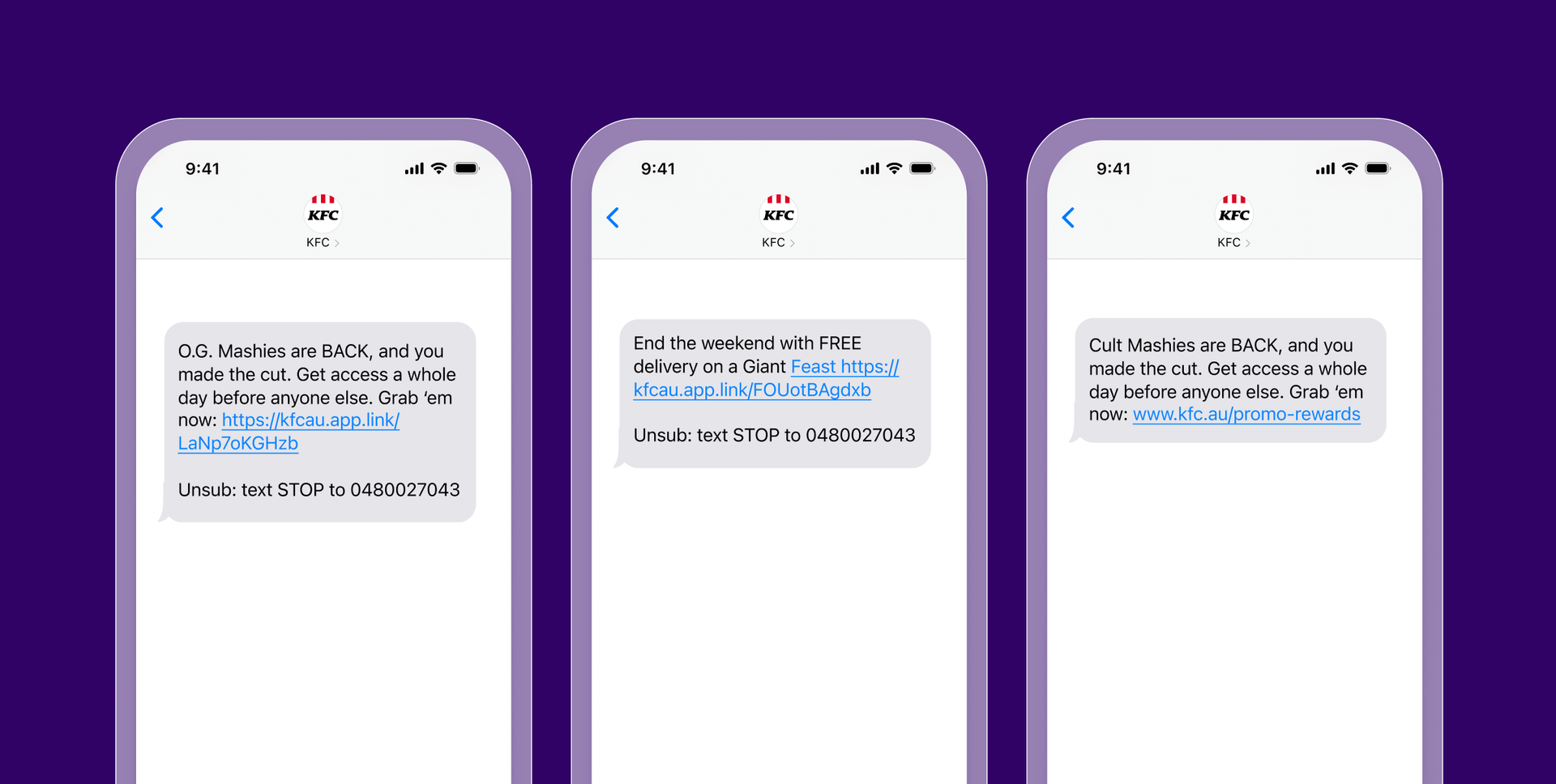
Strategy
Leveraging Braze in partnership with their agency AKQA and Braze Alloys technology partners mParticle and Snowflake, experimentation was the name of the game. They created a campaign between Boxing Day and Australia Day, which they knew to be a high-traffic period, and tested SMS versus mobile push notifications to see which channel was better at driving incremental transactions during this time. The team crafted a suite of dynamic, personalized messages for both audiences in Braze Canvas, a visual development environment which marketers can use as a no-code journey orchestration tool.
Results
KFC Australia saw a 3X increase in purchases with SMS compared to push. Those who received the SMS message also had a 31% increase in incremental sales and a 30% uplift compared to the push control group.
A Braze-powered promo code campaign helps sweetgreen increase new SMS subscribers by 10K
Problem
sweetgreen, the fast-casual restaurant chain famous for its salads and grain bowls, wanted to drive people away from using third-party delivery services towards using the sweetgreen app for ordering and delivering their famous healthy meals.
Strategy
Sweetgreen delivered order discount codes through SMS by partnering with Braze and using our native Promotion Code feature.
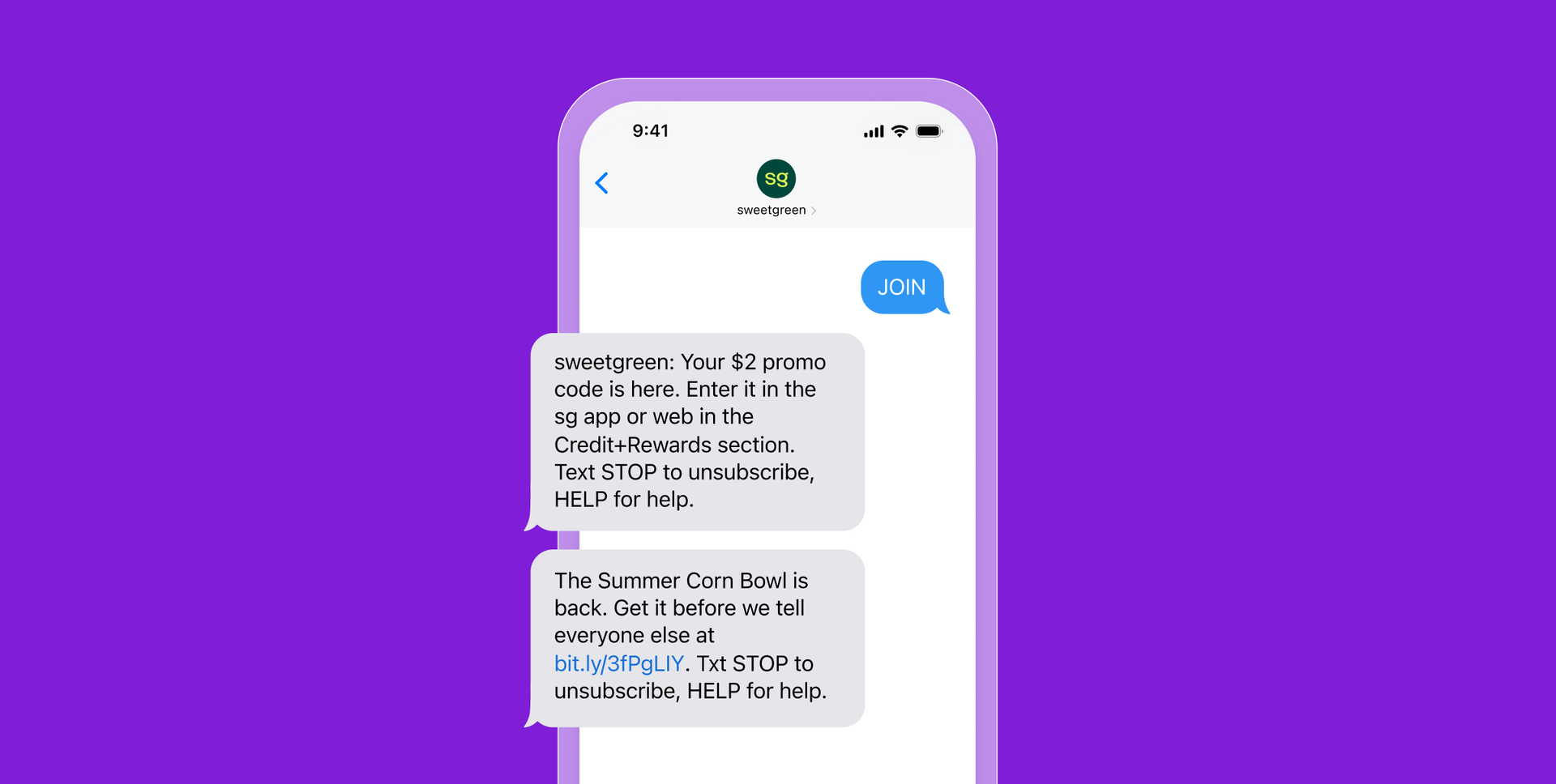
Results
By leveraging SMS as part of their messaging mix, sweetgreen was able to drive 10% conversion rates while also increasing its messageable audience—adding more than 10,000 new subscribers to its SMS channel.
Conversions improve by 206% for PureGym with Braze-powered cross-channel campaigns
Problem
PureGym, the United Kingdom’s largest chain of gyms, was looking to re-engage members who had lapsed and reduce churn. They did this by sending messages containing rejoin offers.
They wanted to reach a wide segment of users, from those who had placed a membership in their online basket but not purchased, to those who’d bought a membership and then lapsed or canceled.
Strategy
PureGym partnered with Braze and Braze Alloys services partner ConsultMyApp to create a cross-channel campaign that would be able to reach all these different audiences and test messages for each group. They would also be able to improve creative content and experiment with message frequency.
PureGym was also able to manage time and costs by combining email and SMS in a single solution using the Braze platform’s Connected Content feature. Discounts were easily managed and delivered and sending and analyzing results was quicker than if the task had been given to their internal team to carry out.
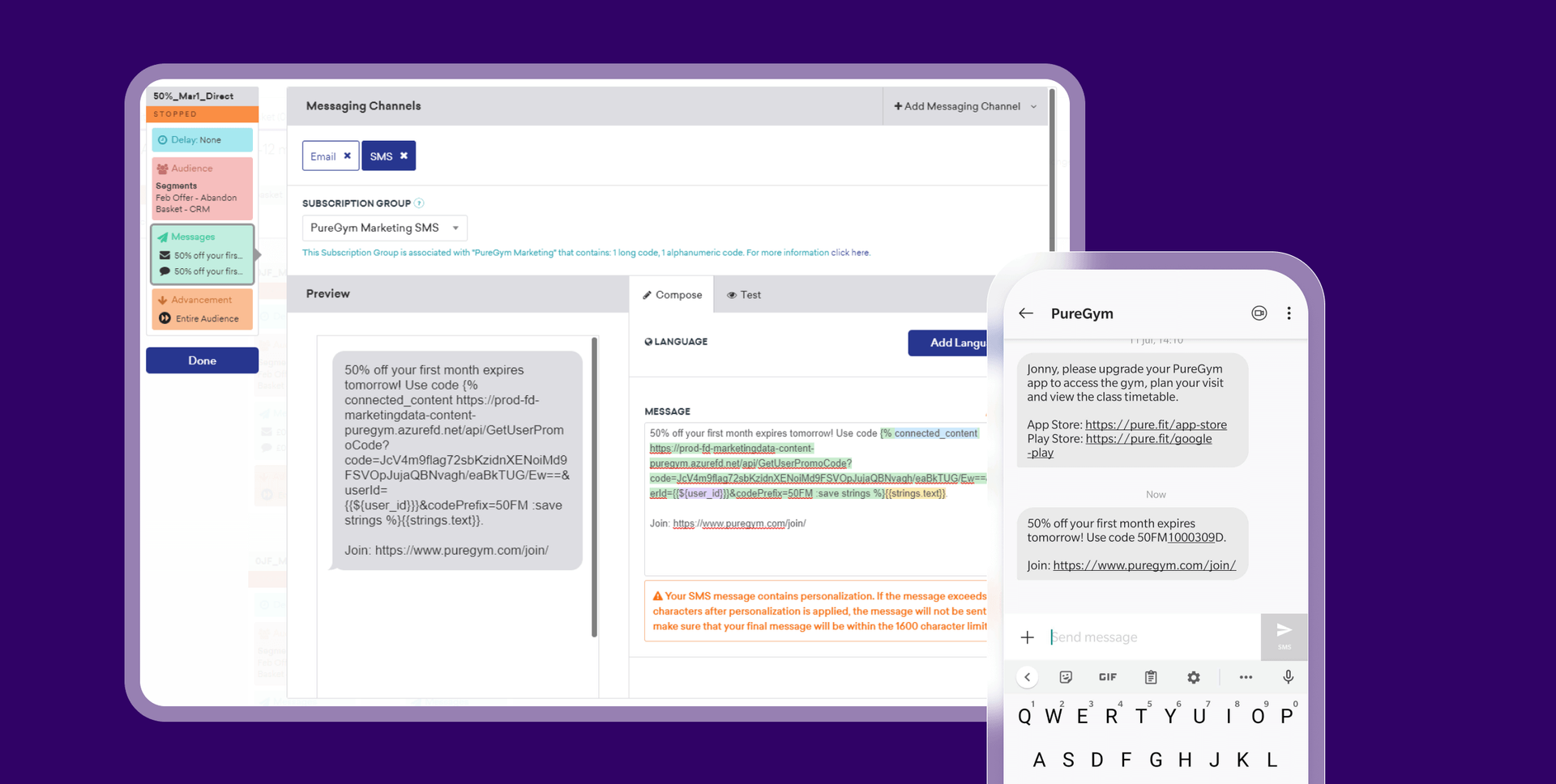
Results
By taking a cross-channel approach and complementing their email campaigns with SMS, PureGym was able to drive significantly stronger results for their email sends. Email open rates went up by 69%, and people who received retargeting emails showed a 206% higher conversion rate, compared to emails sent to all users.
FREE NOW increases driver activation by 47% with Braze
Problem
FREE NOW is a mobility super app for Europe. As well as ride hailing, it now also provides micro-mobility services like eBikes, eMopeds, and eScooters, as well as car sharing. FREE NOW wanted to move away from one-off campaigns towards creating automated communications for customers and drivers.
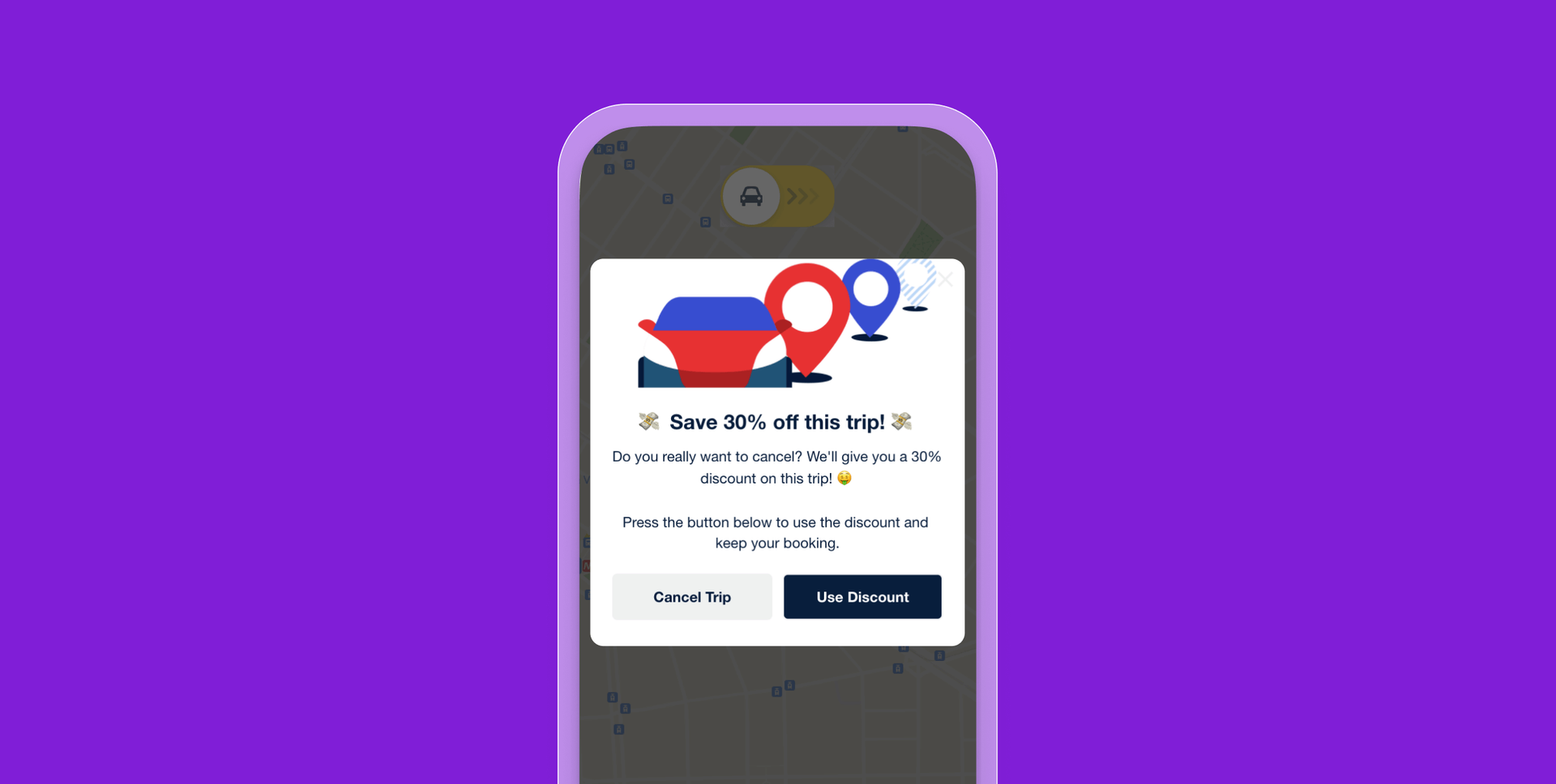
Strategy
Their goals were more ride bookings and completed journeys, fewer cancellations, and more ride supply. FREE NOW created experiments and tested their campaigns. Using Braze Simple Survey in-app messages (IAMs), they collected user attributes, insights, and preferences, then leveraged SMS and email to power campaigns offering vouchers to customers in France who downloaded the app but hadn’t taken any trips.
Results
After leveraging Braze for their campaigns, FREE NOW saw a 47% uptick in activation rates among drivers. With better engaged drivers, they were able to provide passengers with an increased supply of rides, more availability, shorter trip times, and less surge pricing.
Using SMS they activated lapsed users and drove a 33% rise in starting sessions and a 21% increase in created bookings, which in turn led to increased customer satisfaction and retention.
4 ways a best-in-class customer engagement platform can support SMS marketing
SMS is a powerful way to capture attention and engage your customers, but it doesn’t exist in a vacuum. To reach every member of their audience in the ways—and on the channels—they care about, marketers need a unified customer engagement platform that can streamline the integration of SMS alongside other impactful channels like email and in-app messages.
One great example of this sort of best-in-class platform? Braze. The Braze platform was built to be both natively cross channel and channel agnostic from day one, helping to simplify the delivery of personalized, relevant SMS messages and supporting stronger outcomes. Here are four ways that this kind of top-flight platform can support your business’ SMS marketing efforts:
1. Scale with confidence
Supports expanding your list of subscribers quickly and enhance your SMS program using a platform built for compliance, deliverability, and reliability.
2. Engage the right mobile customers
Leverage extensive zero- and first-party preferences, behaviors, and cross-channel interactions to reach high-value mobile customers precisely when it matters.
3. Send relevant texts
Drives a boost in ROI by employing personalized and conversational SMS and MMS messages that grab attention, convert customers, and cultivate brand loyalty through their preferred communication channel.
4. Optimize spend across SMS and other channels
Cut down on both time and costs by consolidating SMS and all other digital channels within a single, centralized customer engagement platform designed for cross-channel optimization.
Final thoughts
With the right strategy and the right platform, SMS marketing can be an integral part of your marketing strategy—so don’t underestimate its place in your marketing mix. We’ve explored how it can help drive impact both alone and when used alongside other messaging channels, as well as how to more effectively build an SMS list and reach customers across a range of key use cases to achieve maximum results.
If you’re looking to scale with confidence and engage your high-value mobile customers with relevant texts that drive revenue, check out Braze SMS and see what’s possible.
SMS marketing FAQs
Are there legal restrictions impacting SMS marketing??
While the sending of SMS marketing messages is generally permitted, it is subject to specific laws and regulations in many jurisdictions.
Most of these laws impose restrictions on the sending of unsolicited SMS Messages, requiring brands that want to leverage SMS to obtain explicit consent from consumers before sending them any messages, as well as to allow consumers to opt out of receiving SMS at any time.
To ensure compliance with the legal requirements applicable to their sending of SMS marketing messages (if any), brands should seek legal advice in their jurisdiction before engaging in SMS marketing. Failure to comply with the legal requirements may result in significant penalties and fines in some jurisdictions.
What is the market for SMS marketing?
The SMS marketing market was valued at $64 billion in 2021. It’s expected to reach $84.9 billion by 2027.
What are the risks associated with SMS marketing?
If SMS is overused, it can lead to customer fatigue and unsubscribes. Frequency capping, which can be used to control the number of SMS you send to a given customer in a specific time period, is a powerful tool for marketers looking to leverage this channel while reducing the risks connected to this sort of over-messaging. In addition, AI send-time optimization (like Braze Intelligent Timing) can personalize when outreach is delivered to each user based on their unique engagement patterns, helping to ensure that messages are sent when people are most likely to be receptive to them.
What is the success rate of SMS marketing?
SMS achieves a 98% open rate and 90% of all SMS messages are opened within 3 minutes. Based on our own data here at Braze, we've found brands that send SMS campaigns can help increase engagement by 139% and monetization by 1,566%, when compared with sending no messages at all.
Related Tags
Releated Content
View the Blog
The new inbox reality: How iOS changes are reshaping email marketing

Aparna Prasad

Experience optimization: Turning data insights into better journeys

Team Braze

December 2025 Bonfire Marketer of the Month: Jagex’s Emma Oliver
